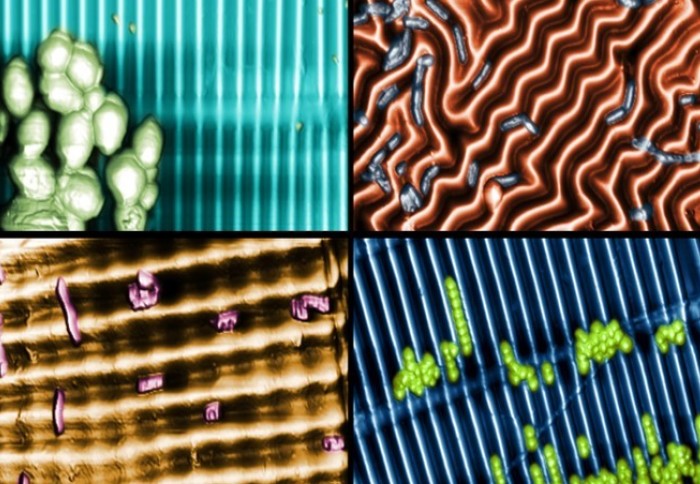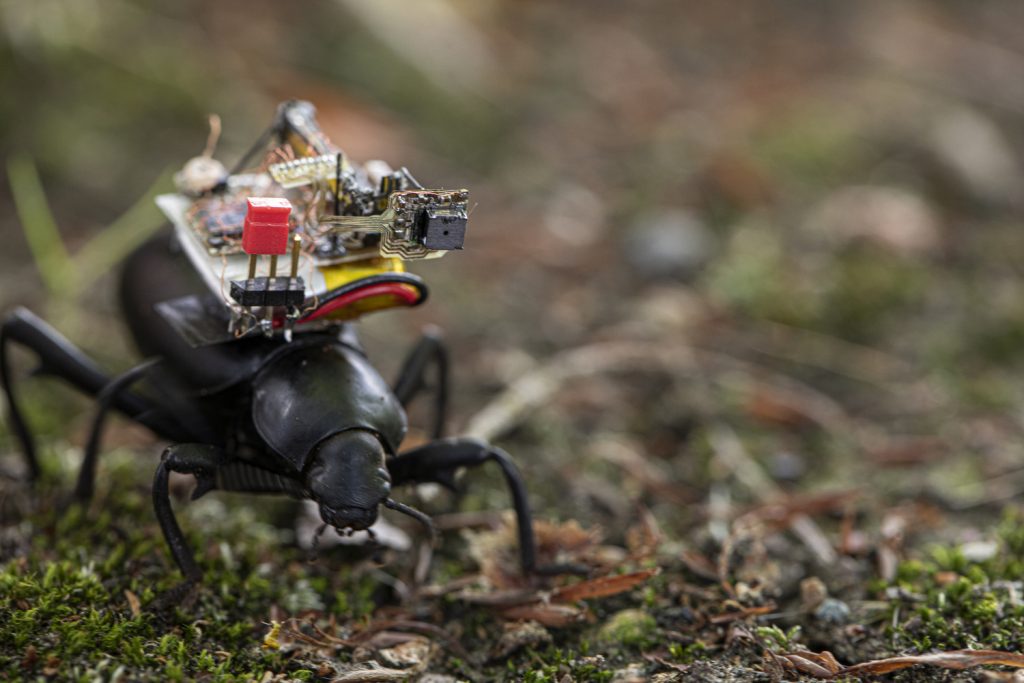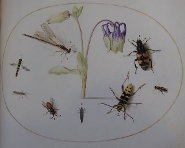Last week, I received (via email) this enticing November 27, 2023 University of British Columbia media advisory,
Welcome, baking enthusiasts and insect epicureans, to the Great UBC Bug
Bake Off!On Nov. 28 [2023], media are invited as four teams of faculty of land and food
systems students engage in a six-legged culinary showdown. Students will
showcase insect-laden dishes that are delicious, nutritious and
environmentally friendly. Esteemed judges, including UBC executive chef
David Speight, will weigh in on the taste, texture and insect ingenuity
of the creations.We spoke to course instructor and sessional lecturer Dr. Yasmin Akhtar
about the competition, and why she advocates for entomophagy – eating
insects and bugs.WHY DO YOU HOST THIS INSECT DISH COMPETITION?
This competition is the culmination of my applied biology course
“Insects as Food and Feed” where we spent the semester learning
about the benefits and risks of eating and using insects. One of my
goals is to reduce the negative perceptions people may have of eating
bugs. This competition is a fun way to raise awareness among students
about the nutritional value of insects, their role in sustainable food
systems and the importance of considering alternative protein sources.WHAT ARE THE BENEFITS OF EATING INSECTS?
In addition to being really tasty, there are two main benefits of eating
insects.Many insects are incredibly nutritious: They are high in protein,
calcium, good fatty acids and vitamins. For example, a species of
grasshoppers commonly eaten in Mexico, Sphenarium purpurascens,
contain 48 grams of protein per 100 grams, compared to 27 grams of
protein per 100 grams of beef. Insect protein is also easily absorbed by
humans and some insects contain all the essential amino acids that
humans need.The other benefit is environmental. Rearing insects requires much less
space, fewer resources like water and much less feed. They produce much
lower greenhouse gas emissions than cattle or pigs, for example. It also
encourages the sustainable use of diverse insect species, rather than
relying on a small number of traditional livestock species to meet the
world’s needs.It is also relatively cheap to rear insects, which means that
small-scale farmers can benefit.WHAT ARE SOME EASY WAYS TO INCORPORATE BUGS INTO YOUR DIET?
Insect flours and insect powders are an easy way to incorporate bugs
into your diet – especially if you are wary of eating insects whole.
You can purchase insect flour online and simply replace wheat flour in
any recipe with the insect flour for tasty, high-protein baked products
like muffins or as filling in samosas.Barbecuing insects is another great option: they absorb flavour really
well, and dry out to become very crunchy. Barbecued crickets are my
favourite! I also really like chocolate-covered ants, and adding insect
powder to green tea.WHAT ARE SOME RISKS OF EATING INSECTS THAT PEOPLE SHOULD BE AWARE OF?
Insects live in a lot of different environments, including soil, and can
be infested with microorganisms like bacteria, fungi and other viruses.
Just like other animal proteins, insects should be treated before they
are consumed – using heat to boil or cook them, for example.If capturing insects from the wild, you need to be aware that they may
be contaminated with pesticides that were used to spray fruits and
vegetables. A better option would be purchase them from insect farms,
where they are safely raised to be used as food.Lastly, if you’re allergic to seafood, then you’ll likely also be
allergic to insects because they share similar protein allergens.EVENT: GREAT UBC BUG BAKE OFF
Date/time: Tuesday, Nov. 28, 11:15 a.m. – 1 p.m.
Contest will begin promptly at 11:30 a.m. so please arrive early to set
up.Location: Vij’s Kitchen, Room 130, 2205 East Mall
As you might have expected, the media attended. From a November 28, 2023 article by Stefan Labbé for vancouverisawesome.com
Inside a culinary lab at the University of British Columbia, nine students took turns offering a menu of insect-infused recipes to a panel of judges.
Beef tacos wrapped in cricket flour-laced tortillas. Mealworm ginger sugar cookies “to add a little protein during the holidays.” And cheesecake with a layer of crushed cricket fudge. Judge and UBC executive chef David Speight snapped off a piece of ginger cookie in his mouth.
“It doesn’t really taste like mealworm,” he said with a smile. “That’s good.”
The competition, billed as the Great UBC Bug Bake Off, pit the students against each other to see who could come up with the tastiest, and perhaps least offensive dish. But for students who had just spent months learning about insects as food and feed, the stakes of eating bugs was much larger.
“We’re going hungry globally,” said UBC student Rozy Etaghene, after presenting her cheesecake.
By 2050, the global population is expected to hit nine million people [sic; the UN projection is for 9.8 billion]. To feed all those mouths, agricultural production will have to double, according to the UN’s Food and Agricultural Organization. But agriculture already takes up 30 per cent of the planet’s land, with up to 70 per cent of that reserved for livestock like cattle, pigs and chickens.
…
But substituting chicken wings for fried crickets is not always an easy sell. A decade ago, Vancouver chef Vikram Vij donated $250,000 to renovate UBC’s culinary lab. At the time, the co-owner of Vij’s restaurants, Meeru Dhalwala, was in the midst of experimentation, first putting insects on the menu in 2008.
It all started with roasted crickets, an insect that requires only two kilograms of feed for every one kilogram of body weight gain. Spiced with cayenne, cumin and coriander, Dhalwala said she would treat them like ground almonds.
“I made a cricket paratha, like a flatbread,” she said. “It was a really big deal at the time.”
…
Back at the UBC culinary lab, the judges had come to a decision: Etaghene’s cheesecake had lost out to a pound cake and plate of cranberry short-bread cookies — both baked with cricket flour.

Labbé’s November 28, 2023 article offers a lot of information on insects as food in Canada and in the world, as well as, more about the bake off.
Another November 28, 2023 article this time written by Cosmin Dzsurdzsa for True North (I have more about True North after the excerpt) highlights other aspects of the event, Note: Links have been removed,
Canadian journalists were so eager to attend the University of British Columbia’s Bug Bake Off on Tuesday [November 28, 2023] to get a taste of edible insect creations that the event was booked to capacity the night before.
…
Former CBC producer and UBC media relations specialist Sachintha Wickramasinghe told True North on Monday that the event was at capacity.
“There’s been significant interest since this morning and we are already at capacity for media,” said Wicramansinghe.
…
There has been growing interest by governments and the private sector to warm consumers up to the idea of edible insects. The Liberal government has lavished edible insect cricket farming companies with hundreds of thousands of dollars worth of subsidies [emphasis mine].
…
For anyone curious about True North, there’s this from the True North Centre for Public Policy Wikipedia entry, Note: Links have been removed,
The True North Centre for Public Policy is a Canadian media outlet that simultaneously describes itself as a “media company”, an “advocacy organization” and as a “registered charity with the government of Canada.”[1][2] It operates a digital media arm known simply as True North [emphasis mine].[3][4]
…
In 1994, the Independent Immigration Aid Association was started with the goal of helping immigrants from the United Kingdom settle in British Columbia.[2][5] According to Daniel Brown, a former director of the charity, a new board of directors took control of the charity in 2017 and renamed it the True North Centre for Public Policy.[2] Control was handed off to three people:[2]
- Kaz Nejatian, a former staffer for United Conservative Party leader Jason Kenney, and current COO of Shopify.[6]
- William McBeath, the director of Training and Marketing for the right-wing Manning Centre for Building Democracy.
- Erynne Schuster, an Edmonton-based lawyer.
Nejatian’s wife, Candice Malcolm, describes herself as the “founder and Editor-In-Chief” of True North.[7][8]
…
The political leanings of the people in charge of True North in its various manifestations don’t seem to have influenced Dzsurdzsa’s November 28, 2023 article unduly. however, I’m a little surprised by the stated size of the industry subsidies made by the Liberal government. I found an $8.5 million dollar investment (isn’t that similar to a subsidy?) for one project alone in a June 29, 2022 article by Nicole Kerwin for Pet Food Processing, Note: A link has been removed,
Agriculture and Agri-Food Canada revealed June 27 [2022] an $8.5 million investment to Aspire, an insect agricultural company, to build a new production facility in Canada. The facility will process cricket-based protein, helping to advance the use of insect proteins in human and pet food products.
According to Agriculture and Agri-Food Canada, food-grade processing of insects is relatively new in Canada, however insect-based proteins create an opportunity for the country’s agri-food industry to develop more sustainable products.
“The strength of Canadian agriculture has always been its openness to new ideas and new approaches,” said Peter Fragiskatos, parliamentary secretary to the Minister of National Revenue and member of Parliament for London North Center. “Aspire [Food Group] is helping to re-shape how we think about agriculture and opening the door to new product and market opportunities.”
Founded in 2013, Aspire strives to tackle worldwide food scarcity with a focus on edible insect production, therefore developing highly nutritious foods and lowering its environmental impact. Currently, the company has production facilities in London, Ontario, and Austin, Texas. In 2020, Aspire purchased 12 acres of land in Ontario to construct what it expects to be the largest automated, food-grade cricket processing facility in the world.
“Aspire is re-imagining what it means to sustainably produce food, and how smart technology can turn that vision into a reality,” said Francious Drouin, parliamentary secretary to the Minister of Agriculture and Agri-food Canada. “Aspire’s innovative facility will help further establish London’s reputation as a hub for cutting-edge technology, strongly contributing to Ontario and Canada’s position as an innovator in agriculture and agri-food.”
Apsire [sic] plans to use the investment, as well as smart technology, to build its first commercial insect production facility in Ontario. The facility will boost Aspire’s insect farming capabilities, providing it with the ability to grow and monitor billions of crickets, which will be used to create nutrient-rich protein ingredients for use in the human and pet food industries.
…
Getting back to the Bake Off, there’s a Canadian Broadcasting Corporation (CBC) video (runtime: 3 mins. 34 secs.),
UBC Bug Bake Off serves up insect dishes
Students at the University of British Columbia have whipped up some protein-rich dishes made with a special ingredient: bugs. Our Science and Climate Specialist Darius Mahdavi tried the insect-laden dishes and brought some for our Dan Burritt as well.
Sadly, you will have to endure a couple of commercials before getting to the ‘main course’.



